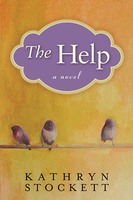I really didn’t want to read this bestseller. I had no desire to revisit the segregated South of the early 1960s, when pretty much the only job available to a woman of color was as a domestic servant. However, when my book club chose it, I gave it a try and found it to be a good read. The book flows well, moving along at a good pace. As one member of my book club said, I had no trouble turning the pages. Also, I was relieved that the book has none of the tacky slapstick I’ve seen in trailers for the film.
Returning to her hometown of Jackson, Mississippi after college without the “Mrs” degree her mother expected her to earn, Skeeter wants to be a journalist. She lands a job on the local paper writing a weekly cleaning advice column, in spite of her never having cleaned anything herself. She can’t ask the loving servant who brought her up, because Constantine has mysteriously up and quit while Skeeter was away at college, so she turns to Aibileen, her friend Elizabeth’s maid, for the requisite information. Observing the way Elizabeth and Skeeter’s other childhood friend, Hilly, treat their help, Skeeter hits on the idea of interviewing domestics to get their point of view. What she doesn’t understand is just how dangerous such confidences can be for her and for any servant daring enough to speak with her.
The story is told in chapters that alternate between Skeeter, Aibileen and Aibileen’s friend and fellow servant, Minnie, a feisty woman whose big mouth has lost her many jobs. The author differentiates the three voices well, but I appreciated each having her own chapter. A framework for these personal stories is provided by the nascent civil rights movement, which is presented (accurately, I think) as rumors from the outside world.
Recently one of my own childhood friends mentioned how lucky we were to have the love and guidance of these extra parental figures. She’s right, but of course the relationship was vastly more complicated. Even as a child I wondered who cared for our maid’s children while she fixed peanut butter and jelly sandwiches for us. At the same time I understood that, as my mother pointed out, we were providing jobs and financial sustenance for women who had few other options.
To her credit, Stockett uses Skeeter’s research to open up the “Mammy” myth from Gone with the Wind: the belief that servants are part of the family, loving and beloved. For instance, Aibileen talks about how when the children grow up enough to learn their parents’ prejudices, she moves on to work for another family with younger children.
However, I don’t think Stockett goes far enough. The good characters are very good, and the bad characters are awful. More inner conflict for them would make the story more realistic–not, I hasten to add, that there weren’t people who behaved as badly as the villains here, but in my experience there’s a least some redeeming feature. Also, having been a servant myself, though without the burden of racial prejudice, I would expect that love for the employer’s children would not be unmixed with other emotions. Similarly, friendship of a sort can certainly exist between employer and domestic, but when my mother declared that she and her maid were best friends, I could only shake my head at her naïveté.
These relationships are complicated. And I think Stockett could have captured more of that complexity instead of falling back on Pollyannas and happy endings. While I congratulate her for tackling the issue at all and for working so hard to capture voices from both sides, I would much rather have read a story written by a woman of color who had worked as a domestic servant and who could therefore have created more genuine characters.

